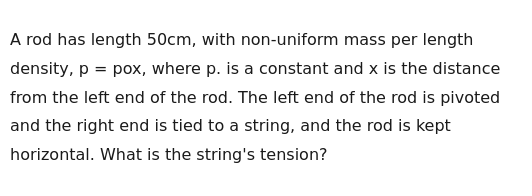Question
Question: A rod has length 50cm, with non-uniform mass per length density, p = pox, where p. is a constant and...
A rod has length 50cm, with non-uniform mass per length density, p = pox, where p. is a constant and x is the distance from the left end of the rod. The left end of the rod is pivoted and the right end is tied to a string, and the rod is kept horizontal. What is the string's tension?

1/12 * ρ₀ * g
Solution
The rod has length L=50 cm = 0.5 m.
The mass per unit length density is given by ρ=ρ0x, where x is the distance from the left end (pivot).
First, we find the total mass M of the rod by integrating the density over the length:
M=∫0Lρdx=∫0Lρ0xdx=ρ0[2x2]0L=ρ02L2.
Next, we find the position of the center of mass xCM from the left end:
xCM=∫0Ldm∫0Lxdm=M∫0Lx(ρ0xdx)=M∫0Lρ0x2dx=Mρ0[3x3]0L=Mρ03L3.
Substituting M=ρ02L2:
xCM=ρ02L2ρ03L3=L2/2L3/3=32L.
The rod is in horizontal equilibrium, pivoted at the left end and supported by a string at the right end. The forces acting on the rod are:
- The weight of the rod, W=Mg, acting vertically downwards at the center of mass xCM=32L from the pivot.
- The tension T in the string, acting vertically upwards at the right end, which is at a distance L from the pivot.
- The reaction force at the pivot (which does not create torque about the pivot).
For rotational equilibrium about the pivot, the net torque must be zero. Taking counter-clockwise torque as positive:
∑τpivot=0
The torque due to tension is T×L (counter-clockwise).
The torque due to weight is W×xCM (clockwise).
T×L−W×xCM=0
TL=WxCM
TL=(Mg)(32L)
T=Mg32.
Substitute the expression for M=ρ02L2:
T=(ρ02L2)g32=ρ03L2g.
Now, substitute the given length L=50 cm = 0.5 m:
T=ρ03(0.5 m)2g=ρ030.25 m2g=ρ031/4g=121ρ0g.
The tension in the string is 121ρ0g.
